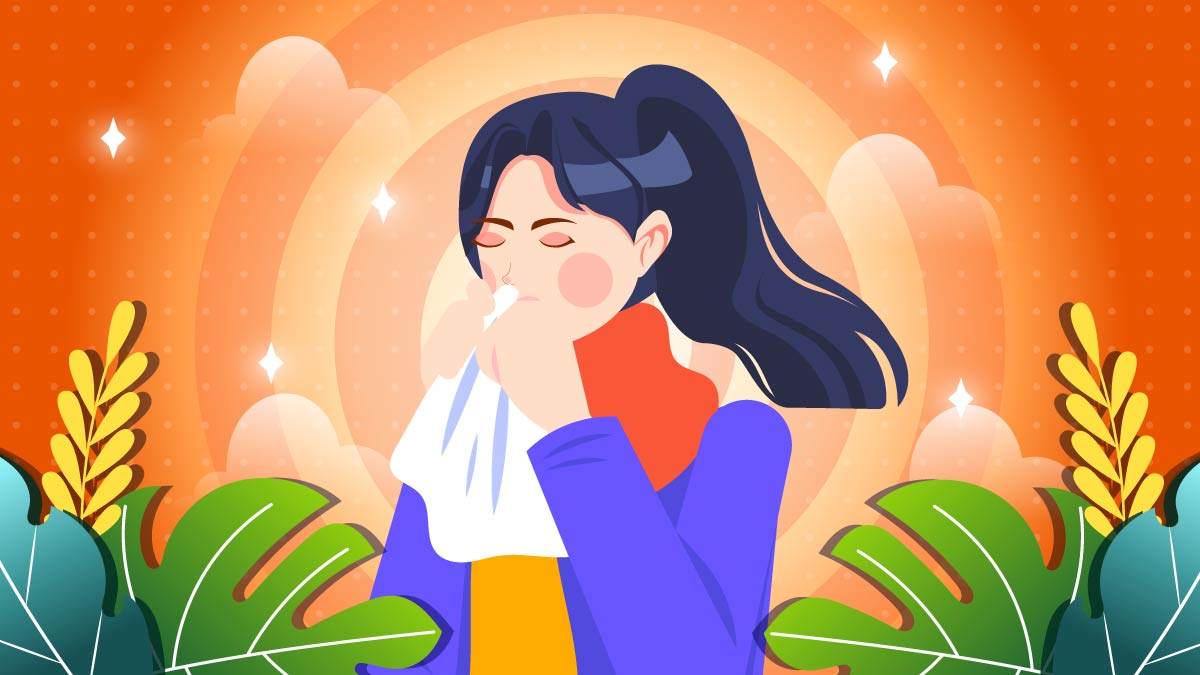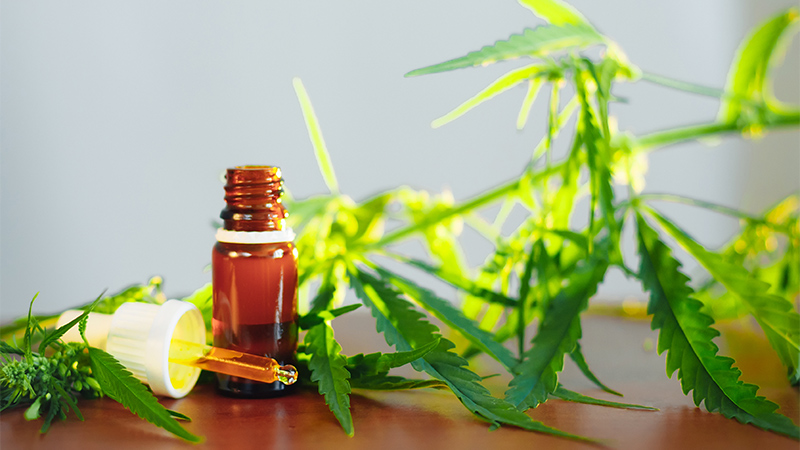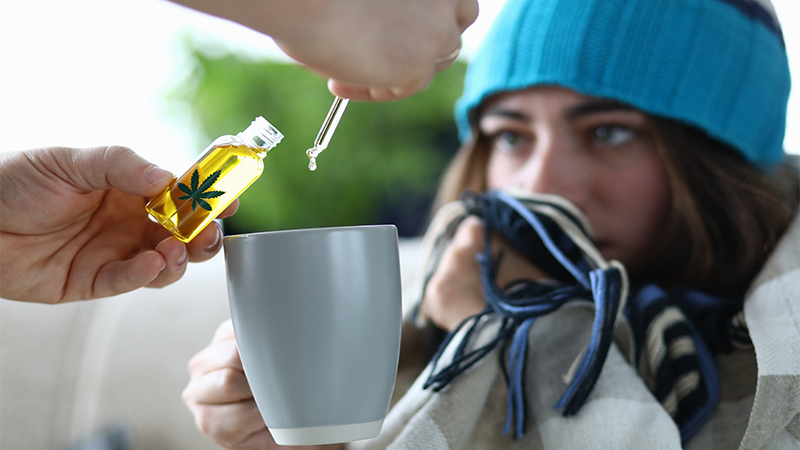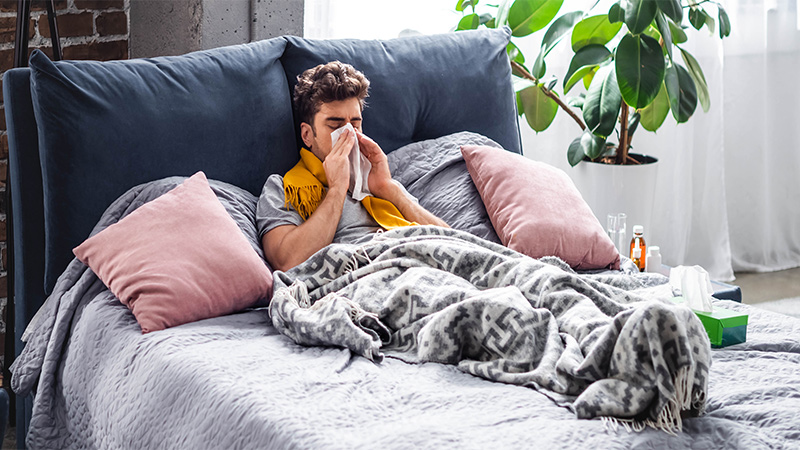CBD Oil for Colds: Does It Help With Flu Symptoms?

Brace yourselves — winter is coming!
Following the famous quote from Game of Thrones, it’s time to prepare for the colds and flu season.
Very few people make it through the winter without an annoying sore throat or colds.
Sure, you can go down the conventional route, get some anti-cold medications or even a flu shot that is laden with unknown chemicals, but you may just as well turn to natural remedies for help.
What many doctors won’t tell you is that it’s best to support your natural immunity while letting colds and cases of flu run their course. Natural solutions include herbs, teas, vitamins, minerals, and plant-based extracts — such as CBD oil.
In this article, we shed some light on how to use CBD to boost your immune system, preventing your body from catching infections.
CBD for Colds: Does It Help?
The common cold is triggered by inflammation that occurs in a person’s nasal and upper respiratory tract. Although many viruses can cause a cold or flu, rhinoviruses are to blame most of the time.
Experiencing a sore throat, congestion, runny nose, cough, sneezing, mild fever, headaches, and body aches, are some of the most common symptoms of colds.
There is no known cure for colds, but most cases go away within two weeks when a person uses natural remedies to control symptoms.
CBD (cannabidiol) has demonstrated antibacterial and antiviral properties in many studies — showing itself as a potential therapeutic agent for colds.
Scientists found that CBD has anti-inflammatory and analgesic properties. Together with another major compound, THC (tetrahydrocannabinol), it can be found in Sativex, a mouth spray used to relieve pain and spasticity.
One study concluded that CBD was able to improve the quality of sleep in patients with anxiety disorders.
Poor sleep is often associated with susceptibility to the common cold. According to one study, people with low-quality sleep are more prone to getting sick upon exposure to rhinoviruses.
Despite positive initial findings, there’s no direct scientific evidence to prove that CBD can cure colds.
How CBD Oil Works to Help with Colds
Researchers have found that CBD interacts with receptors of the endocannabinoid system (ECS), a major regulatory network that modulates several vital functions throughout the body.
CBD’s relationship with the ECS is believed to be the reason for its immunosuppressant effects. Using this mechanism, CBD can improve the communication between the immune cells and selectively shut down overactive parts of the immune system — reducing inflammation.
In a 2008 study, CBD was found to modulate sleep-wake cycles through its interaction with the ECS.
The sleep-wake cycle can be modulated through the activation of the CB1 receptor. While CBD doesn’t directly bind to CB1, it signals the ECS to produce more endocannabinoids that activate it; it also slows down their breakdown, so in the end, more endocannabinoids can bind to CB1 receptors and contribute to a more restful sleep.
CBD activates the CB2 receptor, which, according to a study on respiratory viral infection, is responsible for anti-inflammatory effects in the body.
Why Is It Worth to Use CBD Oil for Colds?

- According to the aforementioned studies, CBD might benefit people with colds and flu due to its ability to reduce symptoms of the illness, such as inflammation and pain.
- CBD oils can improve sleep quality in anxiety patients. Poor quality sleep is linked to a weakened immune system and a higher susceptibility to infections.
- Unlike THC, the intoxicating ingredient in medical cannabis, CBD doesn’t have mind-altering effects, so it won’t affect your daily performance.
- CBD is legal in the USA. You can purchase it without prescription in CBD stores near you or online.
- The FDA supports research on the potential therapeutic properties of cannabis plants and their derivatives.
What Are the Limitations of Using CBD Oil for Colds?
- No study has yet examined a direct link between CBD use and the symptoms of colds and flu.
- Despite its excellent safety profile, CBD can have some mild side effects in high doses. In humans, the observed adverse effects include diarrhea, dry mouth, dizziness, and changes in appetite.
- The CBD market isn’t regulated, so CBD products lack standardization and come with a high risk of mislabeling.
- Currently, the only FDA-approved medication from CBD is Epidiolex — an antiepileptic drug based on a synthetic version of CBD isolate. There are no other official marketing applications for CBD.
CBD vs Other Natural Treatments for Colds
Vitamin C, probiotics, and zinc are often mentioned as potential preventive and interventional methods for the common cold.
Data on Vitamin C shows that the compound can cause a decrease in the duration of colds in subjects.
Zinc intake within 24 hours of symptom onset was found to mitigate the severity of flu symptoms and colds in participants.
Probiotics are beneficial in protecting your system against upper respiratory tract infections due to their antiviral properties.
Taken together with these aforementioned compounds, CBD can work with them in a synergy, enhancing the efficacy of your cold treatment.
You can also find many CBD products today that are infused with vitamin C, probiotics, and zinc.
How to Choose CBD for Colds
There are three main types of CBD when it comes to common colds: full-spectrum, broad-spectrum, and CBD isolate.
The most desired type is the full-spectrum option. Such products contain all of the naturally occurring compounds found in hemp — including CBD, adjunctive cannabinoids, terpenes, and trace amounts of THC.
Full-spectrum CBD creates the entourage effect, which refers to the synergistic effects achieved by the aforementioned compounds. The entourage effect makes whole-plant extracts more effective and predictable when it comes to dosing.
Broad-spectrum CBD is much like its full-spectrum counterpart, except for the lack of THC. The intoxicating cannabinoid is removed after initial extraction to create a zero-THC product that still benefits from some parts of the entourage effect.
Finally, CBD isolate refers to pure CBD, which has been isolated from other hemp compounds and turned into whitish crystals. These crystals are then powdered and infused into a range of CBD products, such as oils, edibles, capsules, vapes, and topicals. Although isolates carry the highest dose of CBD per serving, they don’t evoke the entourage effect — making them the least desired option.
Tips for Finding the Right CBD Oil:
- Look for a certificate of analysis of the desired CBD product. This is a form of a lab report that shows the results for the product’s potency and purity.
- Choose high potency CBD oils derived from organic hemp. Such plants are grown in natural conditions, without pesticides and artificial boosters, so they’re cleaner and contain higher concentrations of CBD than mass-produced hemp.
- Opt for CO2-extracted products. CO2 extraction is the industry’s golden standard; it doesn’t require adding extra heat or toxic solvents and ensures the highest purity and consistency in potency in all product batches.
- Purchase products with targeted formulas. As mentioned, CBD oil can be infused with other complementary compounds, such as vitamin C, vitamin D, probiotics, and zinc.
- Consult a doctor experienced in cannabis use before purchasing CBD. Doing so will help you determine the right dosage and avoid potential interactions with other medications.
CBD Dosage for Colds

Since CBD products aren’t regulated in the USA, there are no official guides or charts for CBD dosage.
However, taking a look at human clinical trials using CBD may provide insight for a safe and relatively accurate CBD dosage range.
For example, using CBD for anxiety may require doses between 25–175 mg per day of CBD. These amounts are enough to produce a significant clinical response. However, the study’s authors used pure CBD, not a whole-plant extract, so the dosage may change depending on what kind of product you’re using.
CBD is also safe and well-tolerated in humans. Studies have shown that doses of CBD can reach as high as 1,500 mg per day without any dangerous side effects.
How to Take CBD Oil for Colds
The best way to take CBD for cold and sore throat is through oil or tincture. CBD oils are usually administered sublingually (under the tongue) and held there for up to 60 seconds.
You can also take CBD directly — as gummies or capsules — which is a great way to use CBD for beginners. That’s because they’re straightforward and contain a premeasured amount of CBD.
Vaping is another way to get CBD into your system. It offers the highest bioavailability and the fastest onset of effects. However, this form of consumption may not be recommended if you cough because it can irritate your airways, causing more cough, sore throat, and sneezing.
Why Do We Get Colds and Flus?

This is actually a quite difficult question to answer, but most of the time, it boils down to the following triggers:
- Being constantly in confined areas with other infected people who have influenza. Viruses become airborne when someone coughs, so it can only take a few breaths to catch the illness.
- Constant mutations of rhinoviruses. Unfortunately, our immune systems need some time to adjust to these ever-changing germs, and catching a cold or flu is actually a sign of a “system upgrade.”
- Touching items that have been touched by an infected person. Viruses can survive on non-porous surfaces for hours, so it’s possible to get sick by getting a second-hand infection.
How do Viruses Affect Our Body?
Colds and cases of flu are simply the outcomes of viruses attacking our bodies. Viruses are microscopic molecules of genetic material, covered by a thin layer of protein. Unlike the normal cells in our body, these viruses aren’t able to reproduce on their own, instead, they use the metabolism of your cells to produce many clones of themselves.
When a virus enters a cell, it will either use its constituents to copy itself, eventually breaking the cell seeking a new one, or, injecting itself into the DNA of your cell. By doing so, the virus can pass down through natural cell division (cytokinesis) and genetic duplication (mitosis).
Key Takeaways on Using CBD Oil for Colds
CBD has remarkable anti-inflammatory and anti-viral properties that may prove beneficial for individuals with a common cold or flu.
The cannabinoid interacts with various receptors of the ECS, which improve its ability to regulate immune response — enhancing your immunity as a result.
Not only that, but CBD can also curb inflammation and pain, which are the two common symptoms of a cold. On top of that, it can also help improve sleep in people with anxiety. Poor sleep is one of the major reasons why people have compromised immune systems.
You can add some zinc, probiotics, and vitamin C to your daily routine as preventive measures against colds. Holistic supplementation will help enhance your immune system and keep you resistant to illnesses.
Do you take CBD for colds? What other ingredients do you throw into your remedy box when you’re sick? Let us know by leaving a comment below!
References:
- Jennings, L. C., & Dick, E. C. (1987). Transmission and control of rhinovirus colds. European journal of epidemiology, 3(4), 327–335. https://doi.org/10.1007/BF00145641
- Blaskovich, M., Kavanagh, A. M., Elliott, A. G., Zhang, B., Ramu, S., Amado, M., Lowe, G. J., Hinton, A. O., Pham, D., Zuegg, J., Beare, N., Quach, D., Sharp, M. D., Pogliano, J., Rogers, A. P., Lyras, D., Tan, L., West, N. P., Crawford, D. W., Peterson, M. L., … Thurn, M. (2021). The antimicrobial potential of cannabidiol. Communications biology, 4(1), 7. https://doi.org/10.1038/s42003-020-01530-y [2]
- Nagarkatti, P., Pandey, R., Rieder, S. A., Hegde, V. L., & Nagarkatti, M. (2009). Cannabinoids as novel anti-inflammatory drugs. Future medicinal chemistry, 1(7), 1333–1349. https://doi.org/10.4155/fmc.09.93
- Markovà, J., Essner, U., Akmaz, B., Marinelli, M., Trompke, C., Lentschat, A., & Vila, C. (2019). Sativex® as add-on therapy vs. further optimized first-line ANTispastics (SAVANT) in resistant multiple sclerosis spasticity: a double-blind, placebo-controlled randomised clinical trial. The International journal of neuroscience, 129(2), 119–128. https://doi.org/10.1080/00207454.2018.1481066 [4]
- Shannon, S., Lewis, N., Lee, H., & Hughes, S. (2019). Cannabidiol in Anxiety and Sleep: A Large Case Series. The Permanente journal, 23, 18–041. https://doi.org/10.7812/TPP/18-041
- Khan, M. I., Sobocińska, A. A., Czarnecka, A. M., Król, M., Botta, B., & Szczylik, C. (2016). The Therapeutic Aspects of the Endocannabinoid System (ECS) for Cancer and their Development: From Nature to Laboratory. Current pharmaceutical design, 22(12), 1756–1766. https://doi.org/10.2174/1381612822666151211094901
- Nichols, J. M., & Kaplan, B. (2020). Immune Responses Regulated by Cannabidiol. Cannabis and cannabinoid research, 5(1), 12–31. https://doi.org/10.1089/can.2018.0073 [7]
- Murillo-Rodríguez, E., Millán-Aldaco, D., Palomero-Rivero, M., Mechoulam, R., & Drucker-Colín, R. (2008). The nonpsychoactive Cannabis constituent cannabidiol is a wake-inducing agent. Behavioral neuroscience, 122(6), 1378–1382. https://doi.org/10.1037/a0013278
- Dhopeshwarkar, A., & Mackie, K. (2014). CB2 Cannabinoid receptors as a therapeutic target-what does the future hold?. Molecular pharmacology, 86(4), 430–437. https://doi.org/10.1124/mol.114.094649
- Hemilä, H., & Chalker, E. (2013). Vitamin C for preventing and treating the common cold. The Cochrane database of systematic reviews, 2013(1), CD000980. https://doi.org/10.1002/14651858.CD000980.pub4
- Rao, G., & Rowland, K. (2011). PURLs: Zinc for the common cold–not if, but when. The Journal of family practice, 60(11), 669–671.
- AL KASSAA I. (2016). Antiviral Probiotics: A New Concept in Medical Sciences. New Insights on Antiviral Probiotics: From Research to Applications, 1–46. https://doi.org/10.1007/978-3-319-49688-7_1 [12]
- Russo E. B. (2011). Taming THC: potential cannabis synergy and phytocannabinoid-terpenoid entourage effects. British journal of pharmacology, 163(7), 1344–1364. https://doi.org/10.1111/j.1476-5381.2011.01238.x